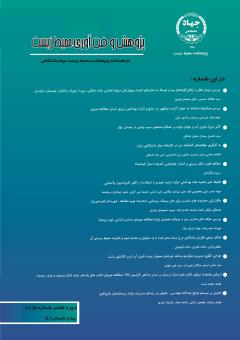بررسی رویش قطر و ارتفاع گونههای بید و توسکا در محلهای تثبیت بیولوژیکی دیواره لغزشی جاده جنگلی (سری 3 سوردار واتاشان، چمستان، مازندران)
محورهای موضوعی : جنگلها و منابع طبیعی
1 - استاد علوم و مهندسی جنگل، جنگلداری و اقتصاد جنگل، دانشکده منابع طبیعی، دانشگاه تهران
کلید واژه: توسکا, بید, مالچ, تثبیت دیواره, روش زیست¬مهندسی,
چکیده مقاله :
این تحقیق با هدف ارزیابی دو گونه بومی توسکا (Alnus glutinosa L. Gaertn.) و بید (Salix alba L.) از نظر متغیرهای رویشی قطر یقه و ارتفاع تحت سه تیمار شامل کاشت نهالهای دو گونه جنگلی توسکای قشلاقی و بید با مالچهای طبیعی کاه و کلش و خردهچوب و خاک بدون مالچ به عنوان تیمار شاهد (کنترل) استفاده شد. طرح آزمایشات بصورت کرتهای خرد شده و در قالب بلوکهای کاملا تصادفی بود. منطقه مورد مطالعه قطعه 5 سری 3 طرح جنگلداری سوردار واتاشان، در حوزۀ آبخیزداری 49 جنگلهای شمال کشور واقع در چمستان مازندران بود. نتایج نشان داد که روابط رگرسیونی بین قطر و ارتفاع در گونه توسکا وضعیت بهتری نسبت به گونه بید داشت. ضریب تعیین رابطه رگرسونی برای متغیر مستقل قطر یقه و متغیر وابسته ارتفاع در گونه توسکا 65/0 و در گونه بید 42/0 بهدست آمد. با توجه به نتایج تجزیه واریانس گونه های مذکور در قالب بلوک ها و تیمارها فاقد تفاوت معنیدار آماری بودند. تیمار خرده چوب بهترین وضعیت را ایجاد کرد و پس از آن تیمار کاه و کلش و نهایتاً تیمار فضای خالی (بدون گونه) وضعیت نامناسب تری از سایر تیمارها داشته است. در مجموع گونه توسکا از گونه بید شرایط مطلوب تری را درخصوص تطبیق با شرایط زیست مهندسی اعمال شده مطالعه حاضر داشت.
The aim of this study was to evaluate the diameter and height growth of two native species of alder (Alnus glutinosa L. Gaertn.) and willow (Salix alba L.) planted in three treatments including natural mulches of straw, wood chips and bare soil without mulch (as control) treatments. The design of the experiments was in the form of split plots and in the form of completely random blocks located in Chamestan, Mazandaran. The results showed that the regression relationships between diameter and height in alder species were better than those of willow species completely randomly. The study area was in parcels 5 of series 3 district of Surdar -Watashan forestry plan in watershed 49 of forests in the north of the country. The regression coefficient for the independent variable of diameter and dependent variable of height was 0.65 in alder and 0.42 in willow. The results showed that the regression relationship between diameter and height in alder was better than willow species. According to the results of variance analysis, the blocks and treatments did not have a statistically significant difference. The wood chips treatment created the best situation, and after that, the straw treatment and finally the control treatment (bare soil) had a more unfavorable situation than the other treatments. Finally, alder had more favorable conditions for adaptation to the applied bioengineering conditions of the present study vs. willow.
احمدی مقدم، ز. 1392، اثر مالچ بر ميزان حفظ رطوبت خاك، اولین همایش ملی چالشهاي منابع آب و کشاورزی، انجمن آبیاري و زهکشی ایران، دانشگاه آزاد اسلامی واحد خوراسگان، 5 ص.
صادقی، س.ح.ر.، شریفی مقدم، ا. و غلانی، ل.، 1393. اثر کاه و کلش برنج بر تولید رواناب سطحی و هدررفت خاك در کرتهاي کوچک. نشریه حفاظت منابع آب و خاك، (4)3: 83-73.
غلامی، ل.، صادقی، س.ح.ر. و همایی، م. 1393، اثرکاه وکلش برنج بر زمان شروع و ضريب رواناب ناشي از باران، مجله پژوهش آب ايران، (8)15: 40-33.
مجنونیان، ب.، 1390. راهنمای طرح، اجرا و بهره برداری راه¬های جنگلی. نشریه شماره 131 (تجدید نطر اول)، انتشارات معاونت برنامه ريزي و نظارت راهبردي رييس جمهور، امور نظام فني، تهران، ایران، 159 ص.
Adekalu, K.O., Olorunfemi, I.A., and Osunbitan, J.A., 2007. Grass Mulching Effect on Infiltration, Surface Runoff and Soil Loss of three Agricultural Soils in Nigeria. Bioresource Technology, 98: 912–917.
Agassi, M., 1996. Soil Erosion, Conservation, and Rehabilitation. Marcel Dekker, New York. 414p.
Albaladejo Montoro, J., Alvarez Rogel, J., Querejeta, J., Díaz, E. and Castillo, V. 2000. Three hydro-seeding revegetation techniques for soil erosion control on anthropic steep slopes. Land Degrad, Dev, 11: 315–325.
Bhattacharyya, R., Fullen, M.A. and Booth, C.A., 2011. Using palm‐mat geotextiles on an arable soil for water erosion control in the UK. Earth surface processes and landforms, 36(7):933-945.
Binkley, D. and Brown, T.C. 1993. Forest practices as nonpoint sources of pollution in North America, Water Res Bull, 29(5): 729–740.
De Ona J., F, Osorio. And P.A, Garcia. 2009. Assessing the effects of using compost–sludge mixtures to reduce erosion in road embankments. Journal of Hazardous Materials, 164: 1257–1265.
Demir, M. 2007. Impacts, management and functional planning criterion forest road network system in Turkey. Transportation research, part A, policy and practice. 41: 56-68 p.
Fedkiw, J., 1998. Managing multiple uses on national forests, 1905-1995: A 90-year learning experience and it isn’t finished yet. Used forest service publication fs-628, 284 p.
Foltz, R.B. 2012. A comparison of three erosion control mulches on decommissioned forest road corridors in the northern Rocky Mountains, United States. J. Soil Water Conserv, 67(6): 536–544.
Grace, J.M., 2002. Control of sediment export from the forest road prism, ASAE Annu Meeting, 45: 1-6.
Li, X.H., Zhang, Z.Y., Yang, J., Zhang, G.H. and Wang, B. 2011. Effects of Bahia Grass Cover and Mulch on Runoff and Sediment Yield of Sloping Red Soil in Southern China. Pedosphere, 21(2): 238-243.
Smets, T., Poesen, J. and Bochet, E. 2011. Impact of Plot Length on the Effectiveness of Different Soil-Surface Covers in Reducing Runoff and Soil Loss by Water. 25 p.


